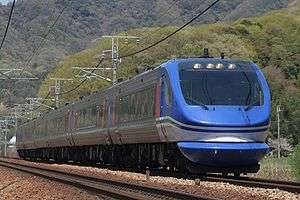Super Hakuto
The Super Hakuto (スーパーはくと) is a limited express train service in Japan operated by the third-sector railway operator Chizu Express and West Japan Railway Company (JR West), which runs between Kyoto and Kurayoshi in Tottori Prefecture at a maximum speed of 130 km/h (80 mph).[1]
 A HOT7000 series DMU on a Super Hakuto service, April 2010 | |
| Overview | |
|---|---|
| Service type | Limited express |
| Status | Operational |
| Locale | Tokaido Main Line, Sanyo Main Line, Chizu Express Chizu Line, Inbi Line, Sanin Main Line |
| First service | 3 December 1994 |
| Current operator(s) | Chizu Express, JR West |
| Route | |
| Start | Kyōto |
| Stops | 17 |
| End | Kurayoshi |
| Distance travelled | 157.8 mi (254 km) (Kyoto - Tottori) 182.2 mi (293.2 km) (Kyoto - Kurayoshi) |
| Average journey time | 3 hours - 3 hours 30 minutes |
| Service frequency | 7 return workings daily |
| On-board services | |
| Class(es) | Standard + Green |
| Technical | |
| Rolling stock | HOT7000 series DMUs |
| Track gauge | 1,067 mm (3 ft 6 in) |
| Electrification | Diesel |
| Operating speed | 130 km/h (80 mph) |
Station stops
Kyōto – Shin-Ōsaka – Ōsaka – Sannomiya – (Kōbe) – Akashi – (Nishi-Akashi) – (Kakogawa) – Himeji – (Aioi) – Kamigōri – Sayo – Ōhara – Chizu – Kōge – Tottori – (Kurayoshi)
- Only Super Hakuto no 13 stops at Kōbe, Nishi-Akashi, and Kakogawa • Only Super Hakuto nos 1 and 3 stop at Aioi • Super Hakuto nos 9 and 13 terminate at Tottori
Rolling stock
Super Hakuto
- HOT7000 series tilting DMUs (since 3 December 1994)
Hakuto
- KiHa 181 series DMUs (3 December 1994 - November 1997)
 KiHa 181 series DMU on a Hakuto service
KiHa 181 series DMU on a Hakuto service
Formation
Services are normally formed of five-car HOT7000 series sets, as shown below, with car 5 at the Kyoto end. All cars are non-smoking, although cars 1 and 5 have smoking rooms.[1]
| Car No. | 1 | 2 | 3 | 4 | 5 | |
|---|---|---|---|---|---|---|
| Numbering | HOT7010 | HOT7030 | HOT7040 | HOT7050 | HOT7000 | |
| Accommodation | Non-reserved | Non-reserved | Reserved | Reserved | Green | Reserved |
| Facilities | Smoking room | Toilet | Universal access toilet | Toilet | Smoking room | |
- Car 5 is sometimes replaced by a HOT7020 car with gangwayed cab end.[1]
History
Super Hakuto services commenced on 3 December 1994.[2] Initially, Hakuto services using JR West KiHa 181 series DMUs were also operated over the same route, but these were discontinued from November 1997, from which date all six return services daily became Super Hakuto operating at a maximum speed of 130 km/h.[2]
All cars were made non-smoking from 1 June 2008, from which time smoking rooms were added to cars 1 and 5.[1]
References
- JR新幹線&特急列車ファイル [JR Shinkansen & Limited Express Train File] (in Japanese). Japan: Kotsu Shimbunsha. 2008. p. 92. ISBN 978-4-330-00608-6.
- こだわりの新幹線&特急列車ガイド [In-depth Shinkansen & Limited Express Guide] (in Japanese). Japan: Ikaros Publishing. August 2000. pp. 136–137. ISBN 4-87149-284-2.
External links
| Wikimedia Commons has media related to Super Hakuto. |
- Chizu Express Super Hakuto (in Japanese)
- JR West Super Hakuto HOT7000 series train information (in Japanese)
.svg.png)